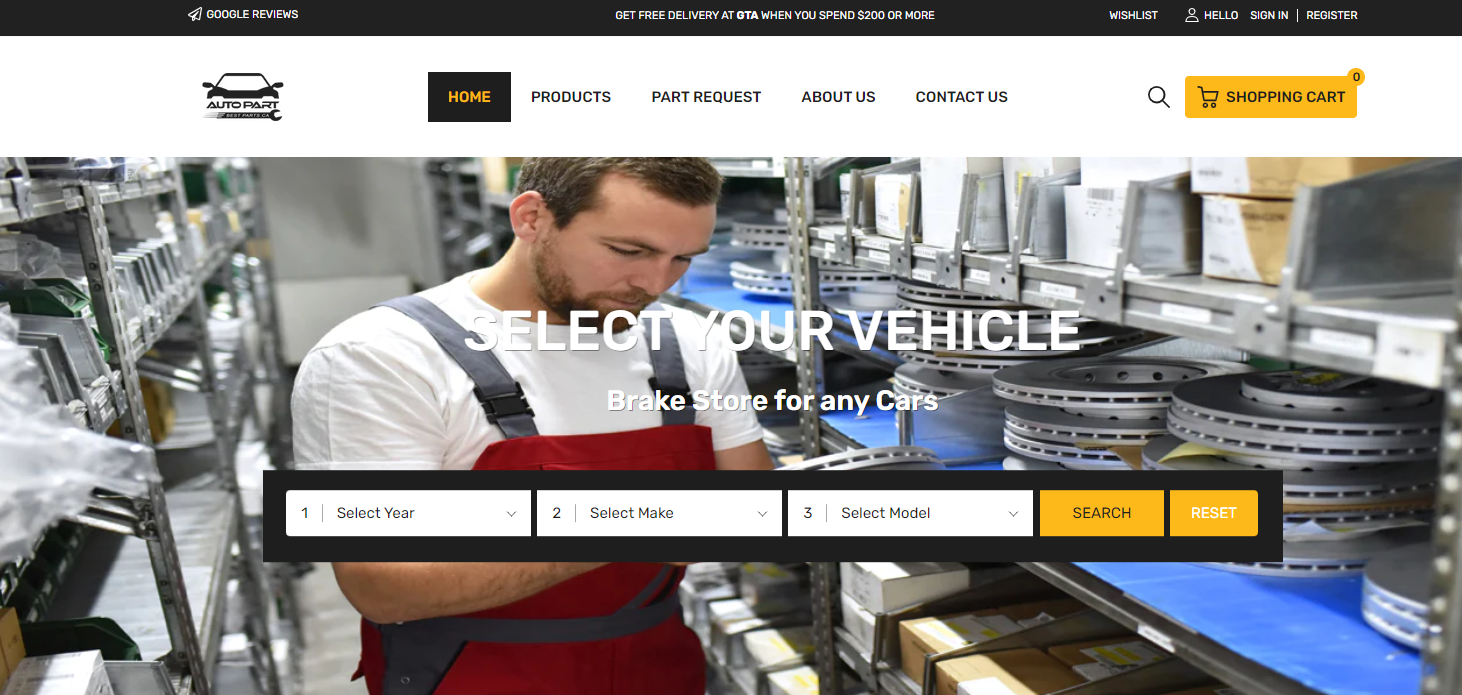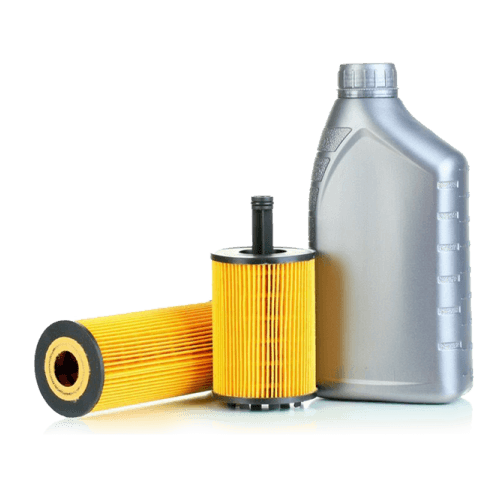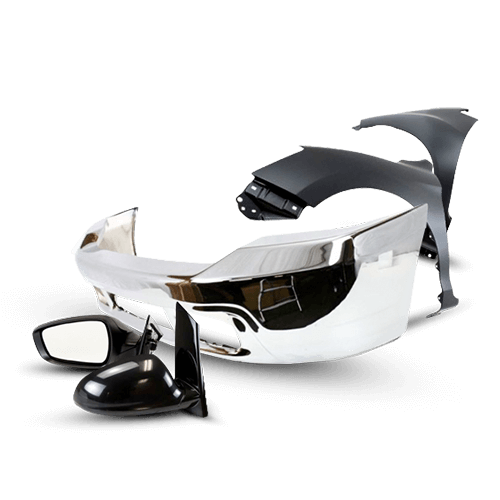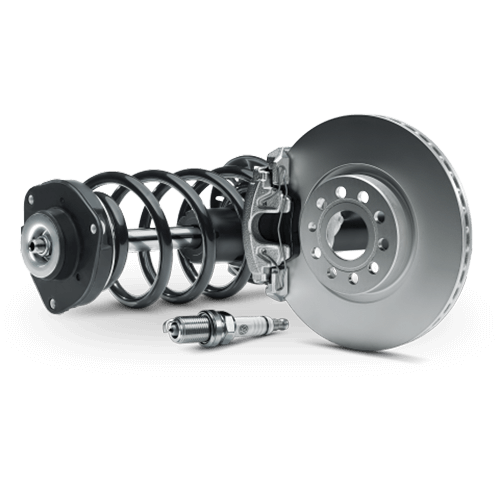Brake rotor
- Featured
- Best selling
- Alphabetically, A-Z
- Alphabetically, Z-A
- Price, low to high
- Price, high to low
- Date, old to new
- Date, new to old
Brake rotor
A brake rotor, also known as a brake disc, is an important component of a vehicle's braking system. It is a flat, circular metal disc that is attached to the wheel hub or axle directly. When you apply the brakes, the brake pads squeeze against the rotor, creating friction that slows or stops the vehicle.
A brake rotor's primary function is to dissipate heat generated during braking. The friction between the brake pads and the brake rotor converts the kinetic energy of the moving vehicle into heat energy. Cooling fins, slots, or holes are incorporated into the rotor's design to improve heat dissipation and prevent overheating. This helps to keep the braking system effective and prevents brake fade, which occurs when the brakes lose their stopping power due to excessive heat.
Typically, car brake rotors are made of cast iron or carbon ceramic. Because of their durability and low cost, cast-iron rotors are more common in most vehicles. High-performance or sports cars, on the other hand, frequently use composite rotors that combine lightweight materials like carbon fiber or ceramic composites with reinforced resins. These composite rotors improve braking performance by providing improved performance, better heat dissipation, and reduced weight.
To ensure proper braking performance and safety, car brake rotors must be maintained and inspected on a regular basis. When replacing brake pads on a regular basis, it is advised to check the brake rotors for any wear or damage.
Types of Brake rotor
There are various types of brake rotors available for vehicles, each designed to meet specific performance requirements or suit specific driving conditions. It should be noted that the selection of brake rotors should take into account factors such as vehicle type, driving style, and intended use. Before choosing a specific type of brake rotor, consult with a qualified mechanic or research the specific requirements for your vehicle model.
Following are some examples of common brake rotor types:
- Solid Rotors: The most basic type of brake rotor is the solid rotor. They are solid cast iron with a uniform, solid construction. Solid rotors are inexpensive and widely used in standard passenger vehicles for daily driving.
- Vented Rotors: Vented rotors, also known as ventilated rotors, have a series of cooling vanes or fins located between the two surfaces of the rotor. These vanes improve cooling performance by allowing air to circulate and dissipate heat more efficiently. Vented rotors are commonly found in high-performance vehicles or those that require frequent or heavy braking, such as sports cars or trucks.
- Slotted Rotors: They are metal discs that have slots or grooves machined into their surface. These slots are strategically placed to improve the braking system's performance and reliability. The purpose of slotted rotors is to improve the effectiveness of the brake by improving heat dissipation and reducing brake fade. The slots help dissipate heat generated during braking, preventing excessive heat buildup that can reduce braking performance.
- Drilled Rotors: Drilled rotors have holes drilled through the surface of the rotor. Weight reduction, improved heat dissipation, and the ability to expel gas, water, and debris are all advantages of these holes. Drilled rotors can improve wet braking performance and provide better initial bite. Drilled rotors are commonly used in sports cars and other vehicles where weight reduction and aesthetic appeal are important considerations.
- Slotted and Drilled Rotors: For improved performance, some rotors combine slotted and drilled features. These rotors offer improved cooling, debris clearance, and reduced brake fade. They are frequently found in high-performance or track-oriented vehicles.
When should we replace the brake rotors?
Because of the friction and heat generated during braking, car brake rotors can wear down over time. This wear can cause uneven surfaces, grooves, or warping, which can cause vibrations, noise, and decreased braking performance. In such situations, the rotors may require replacement depending on their state.
The replacement of brake rotors depends on their condition and wear. While there is no fixed mileage or time interval for replacing brake rotors, there are some signs that indicate they may need replacement. Here are a few examples of common indicators:
Thickness
Brake rotors have a minimum safe thickness specification. If the rotors are worn down close to or below this limit, they should be replaced. Typically, the rotor thickness is stamped on the rotor itself, or you can consult the vehicle's service manual for the specifications.
Scoring or grooves
If the rotor surface has deep scoring or grooves, it can affect brake pad contact and performance. If the grooves are beyond a certain depth, the rotors may need replacement.
Warping or unevenness
Warped or uneven rotors can cause brake pedal pulsation or vibration during braking. If you feel pulsations or shaking in the brake pedal, it may indicate warped rotors that should be replaced.
Damage or cracks
Look for cracks, fractures, or other signs of damage on the rotor surfaces. To ensure safety, replace the rotors if you notice any severe damage.
Excessive rust or corrosion
While some surface rust is normal, excessive rust or corrosion on the rotor surfaces can affect braking performance. If the rust or corrosion is significant, it may be necessary to replace the rotors.
It is essential to have your brake system inspected regularly by a qualified mechanic. They can evaluate the state of your brake rotors and, if necessary, suggest replacement. Additionally, it is frequently advised to inspect the rotors and consider replacement if they are showing signs of damage or are approaching their wear limits when replacing brake pads. For optimum braking performance and safety, proper maintenance and prompt replacement of worn or damaged brake rotors are essential.
Important points of buying Brake rotor
There are several important factors to consider when purchasing brake rotors to ensure you get the right ones for your vehicle and driving needs. Here are some important considerations to bear in mind:
1. Compatibility: Make sure the brake rotors you choose are compatible with the model, and year of your vehicle. Because different vehicles have different rotor sizes, mounting patterns, and specifications, it's critical to match the right rotors to your vehicle.
2. Quality: Purchase high-quality brake rotors from reputable suppliers such as "Best Part". To ensure reliability and performance, quality rotors are typically made of durable materials, precision machined, and subjected to rigorous testing.
3. Rotor Type: Consider the brake rotor that is best suited to your driving style and needs. Solid rotors are appropriate for everyday driving, whereas vented, slotted, or drilled rotors perform better in high-performance vehicles or demanding situations such as aggressive driving. Choose a rotor type that corresponds to your driving habits and specific requirements.
4. Material: Car brake rotors are commonly made of cast iron, but some high-performance vehicles may feature composite or ceramic rotors. Cast iron rotors are cost-effective and suitable for most vehicles, while composite or ceramic rotors offer enhanced performance and reduced weight, but at a higher cost.
5. Brand Reputation and Reviews: Brand Reputation and Reviews: Look into the reputation and reviews of the brand or manufacturer you're thinking about buying from. Look for feedback from other customers and professional reviews to determine the rotors' dependability, durability, and performance.
6. Performance Requirements: Consider your driving patterns and needs, such as everyday commuting, hauling, or high-performance driving, and select brake rotors that fit those demands.
7. Professional Advice: Consult with a qualified mechanic or brake specialist to get specific recommendations for your vehicle and driving needs.
8. Warranty: Check the warranty provided by the manufacturer or seller as well, as a longer warranty period may provide additional peace of mind.
9. Cost: The cost of brake rotors is an important factor to consider when deciding on the right rotor for your vehicle. Brake rotors are available at various price points, depending on factors such as material quality, manufacturing processes, and brand reputation.
One aspect to consider is the intended use of your vehicle. If you primarily engage in everyday city driving with minimal performance demands, opting for more affordable brake rotors may be a practical choice. Solid rotors are often less expensive compared to vented, slotted, or drilled rotors. These solid rotors provide adequate braking performance for regular driving conditions without the need for extra features.
Factors affecting the price of the car rotor
When purchasing car rotors, it is critical to strike a balance between quality, performance, and price. Evaluating your specific needs, consulting with experts, and conducting extensive research can help you make an informed decision while keeping your budget in mind. Finally, several factors can influence the price of automobile rotors. Here are some crucial variables to consider:
1. Material: The rotors' price can be significantly influenced by the material used in their construction. In comparison to composite or ceramic rotors, which are frequently more expensive due to their superior performance characteristics, cast iron rotors are typically more affordable.
2. Rotor Type: Different types of rotors, such as solid, vented, slotted, or drilled, come at varying price points. Enhanced performance features, such as cooling vanes, slots, or drilled holes, can increase the cost compared to basic solid rotors.
3. Brand: The reputation and brand value of the rotor manufacturer can have an impact on the price. Established and well-known brands frequently command higher prices than lesser-known or generic brands.
4. Vehicle Make and Model: The cost of rotors can also vary depending on the vehicle's make and model. Some vehicles necessitate specialized or one-of-a-kind rotors, which may be more expensive due to scarcity or higher manufacturing costs.
5. Performance and Features: High-performance rotors designed for sports cars or vehicles with specific performance requirements tend to be more expensive due to their advanced features and materials.
6. Warranty: The length and scope of the rotor manufacturer's warranty can influence the price. Rotors with longer or more comprehensive warranties may be more expensive.
7. Market Conditions: Rotor prices can be impacted by supply, demand, and competition in the market. Price changes over time can be attributed to a variety of factors, including production costs, the availability of raw materials, and market trends.
Buying Brake rotor Brands Online from Best Parts
Given the importance of the brake rotor in stopping and controlling the vehicle, it is critical to get a high-quality and standard brake rotor that fits your vehicle type.
Are you searching to purchase car brake rotors for your vehicle online as well? As an active online platform in the field of selling all kinds of auto parts, the Best Parts website has made it possible for you to buy all kinds of car brake rotors from among the products offered on this page in only a few clicks.
You can get the rotor of your choice from hundreds of different brake rotors for various cars in the Best Parts online store. By selecting the best brake rotors from Best Parts, you can improve your car's braking performance and drive with confidence. View and purchase your brake rotors online now!






















